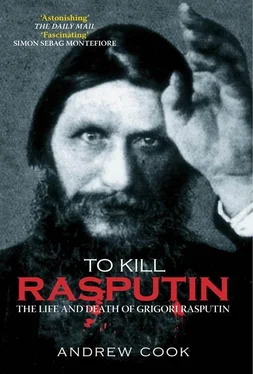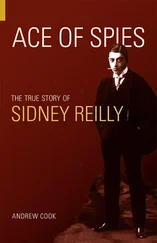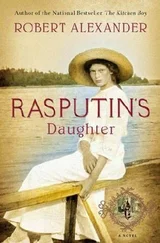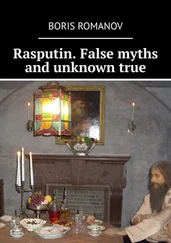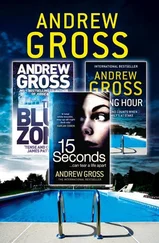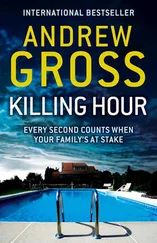Questioned by police almost immediately, Byzhinski the butler was able to indicate ‘The broken window on the ground floor overlooking the forecourt of the adjoining house’.Nobody reported finding any glass outside or hearing it shatter, but in the photographs taken next day, the study window on the courtyard side does look different from the rest; it seems to have some sort of frame, possibly masking tape, around it, and a square of paper on the inside over a hole about 10cm across. The hole is neat, as if broken from the inside at close range. Had there been a man standing in the courtyard, the hole in the window would have been about half a metre above his head.
It is unlikely that either of the two fatal shots hit Rasputin in the middle of the night. According to the Autopsy Report, ‘The victim must rapidly have been weakened by haemorrhaging arising from a wound to the liver (bullet wound 1) and a wound to the kidney (bullet wound 2). Death would have been inevitable within 10 to 20 minutes.' 6
There was more firing hours later, recorded by a whole bevy of police about an hour after their change of shift at six o’clock – firing for which there would have been no need at all had Rasputin received both wounds by three o’clock in the morning.
Shortly after the shot or shots had been heard, Four men allegedly turned up in a car that sped off. Tikhomirov, the Okhrana man ‘detailed to watch Rasputin’, saw them and alerted the head of the Okhrana by telephone. This begs the question of what Tikhomirov was doing there in the first place. Nowhere are we told that he followed Rasputin from Gorokhovaya Street. He does not appear to have a car at his disposal – although there was one on standby at the Ministry of the Interior opposite. We do not know where he was watching from.
It seems likely that Tikhomirov was a late arrival, sent by Protopopov. When the Extraordinary Commission sat in 1917, Protopopov admitted that he had visited Rasputin just after midnight for about ten minutes. 7Yusupov wrote that Rasputin had told him Protopopov had been there that night, and had warned him against visiting the Yusupov Palace. There was allegedly an arrangement whereby, if Rasputin failed to telephone Simanovich by two o’clock in the morning, Simanovich would be concerned and inform the authorities. This is, on balance, quite probable. If Protopopov received a phone call from Simanovich, whom he knew well, he would have sent Tikhomirov to Yusupov’s palace.
If four men did turn up in a car, who were they and why were they there? According to Tikhomirov, they entered by the side door of number 92, which leads us to assume they were arriving by invitation. Princess Irina’s brothers, Princes Andrew, Fyodor and Nikolai are three possibilities whose names had been linked with the murder almost from the beginning.
Assuming that Rasputin had survived an attempt to poison him, the next resort may well have been something just as quiet and bloodless as poisoning, but also fatal: a severe beating.
Given that the protagonists included Dmitri Pavlovich, Yusupov (who would certainly have shrunk from physical violence of that kind, despite the claims he was to make later), 8and Lazovert (who was already physically ill as a result of the tension), 9one might imagine that a tough peasant with a reputation for getting fighting drunk might well have seemed a daunting prospect. Whether, in light of Tikhomirov’s observations, Yusupov subsequently called in extra hands must therefore be considered as a possibility. In any eventuality, the Autopsy Report certainly indicates a range of severe wounds indicative of a major physical assault:
The right eye has come out of its orbital cavity and fallen onto the face. At the corner of the right eye, the skin is torn.
The right ear is torn and partially detached.
The neck has a wound caused by a blunt object.
The victim’s face and body bear the signs of blows inflicted by some flexible but hard object.
The genitals have been crushed.
The left hand side of the back has a gaping wound, inflicted by some sharp object.
In 1993, a team led by Russia’s leading forensic expert, Dr Vladimir Zharov, carried out a thorough review of the autopsy materials. In their report, which was never made public (but was made available to this author), they concur with this view:
The mechanical injuries (the ones not caused by gunshots) in the region of the head were caused by a succession of blows inflicted by heavy, blunt objects. These injuries could not have been caused by the body hitting the pylon of the bridge from which it was thrown off. 10
Furthermore, Zharov’s team listed other wounds not referred to in the Autopsy Report, such as a ‘squashed and deformed’ nose and numerous ‘scratches of irregular shape’. One such irregular shape was the Russian letter G, the fourth letter of the Cyrillic alphabet, which was scratched on the right jaw, possibly by a sword or knife. The most probable explanation is that Rasputin was beaten up by a number of assailants before he was shot, and that one was armed with a truncheon. Zharov and his colleagues further speculate that ‘The gaping wound’ on the left hand side of the back may have been made by a sword or a knife. Had a sword or knife been plunged into his left side, Rasputin might have been left for dead in the basement dining room.
Following the beating, the participants no doubt retired upstairs to the study to relieve the night’s tension and to toast their success with a bout of drinking.
In their books, Purishkevich and Yusupov have Rasputin climbing the stairs unaided and escaping into the yard, whereupon he sprints for the gate (i. E. a thirty-metre dash through snow, part of it in the shadow of the building). Purishkevich allegedly fires four times and hits him twice. The courtyard is unlit. Purishkevich is short-sighted.
According to the Autopsy Report, two bullets were fired from a distance of 20cm and one with the gun pressed to his forehead. We can discount Purishkevich’s entire confection; Rasputin was not hit by bullets when he was on the run. But he could have staggered out, drunk and wounded. And another drunken person, who knew he had escaped, could have shot wildly from the study into the courtyard – the hole in the window is quite neat, as if fired at close range, and it is on the side of the window that a person would fire from if they were aiming towards the snow-heap and the fence. A bullet or two overhead would have made Rasputin fall to the ground, and he would not have been clearly visible from beyond the fence because of the snow-heaps.
There were bloodstains, which Yusupov wanted to disguise, leading from the outer door along the wall and along the fence. There is a police scene of crime photograph that purports to show blood traces in the snow. It is possible that Rasputin somehow escaped, and, dripping blood, collapsed in the yard and was left there, with nobody quite daring to brave the watching police and approach him.
It was this shot or shots from the window that resulted in the first visit by the police. It was as a result of this occurrence that Yusupov invented the shot-dog story. According to Yusupov, he knew there were bloodstains in the snow, and, in order to confuse forensic analysis, he decided to have a dog shot and drag its body over the bloodstains. This is frankly ludicrous. Blood does not stain snow. Even in sub-zero temperatures, blood in snow can be shovelled into buckets and flushed down the nearest drain. It is more likely that Yusupov was making excuses for the presence of a dark shape near the snow-heaps by the fence. Either that, or he was too drunk to think straight. Furthermore, his claim that, on his instructions, a servant then shot a dog makes little sense either. No one in the vicinity claims or recalls hearing this shot, which would, according to Yusupov’s story, have occurred sometime after the shot or shots heard at half-past two or three o’clock, but a good while before the shots heard just after six o’clock.
Читать дальше
